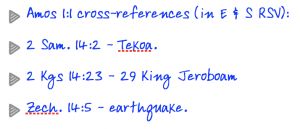The more you read the more you need to note. If you are working with pen and paper you need a new page or a separate notebook. If you are on your personal computer you should start a new document in your word processing application (and unless it automatically saves itself for you, please save at regular intervals without being reminded). Every time you find a fact that may be useful you need to note what it is and where it came from. So here is an entry from my notes:
See how I have used some abbreviations in my personal notes. “2 Sam., 2 Kgs. and Zech.” are standard abbreviations for the books and need no clarification. “RSV” is a standard abbreviation for Revised Standard Version. “E & S” is Eyre and Spottiswoode. As this is an edition I use a great deal I know what it means and there is no possibility of me forgetting. Make sure that your abbreviations still make sense to you at the end of the essay and beyond.
Sad story coming up. As a student I devised an elaborate system of abbreviations and codes to help me take full notes during class. If I decoded them soon after I usually managed to make a good job of it and I am pleased with those particular notebooks. Those I left for another day are now almost meaningless as I no longer remember what all my arcane symbols meant. So please, if you are writing in a private shorthand, ensure you “translate” at the earliest opportunity.
You may also want to think about adding emphasis to your notes. Particularly important points could be underlined, written in a different colour, or highlighted in some other way. With a word processor it is easy to SWITCH TO CAPS and then revert back to normal but if you are writing by hand you might not be able to change your mind so easily. Try not to emphasise everything. IF YOU WRITE ALL YOUR NOTES IN CAPITALS NOTHING WILL STAND OUT except that which is written smaller.
< Step Five (cont.): Research Step Five (cont.): Keep researching >

